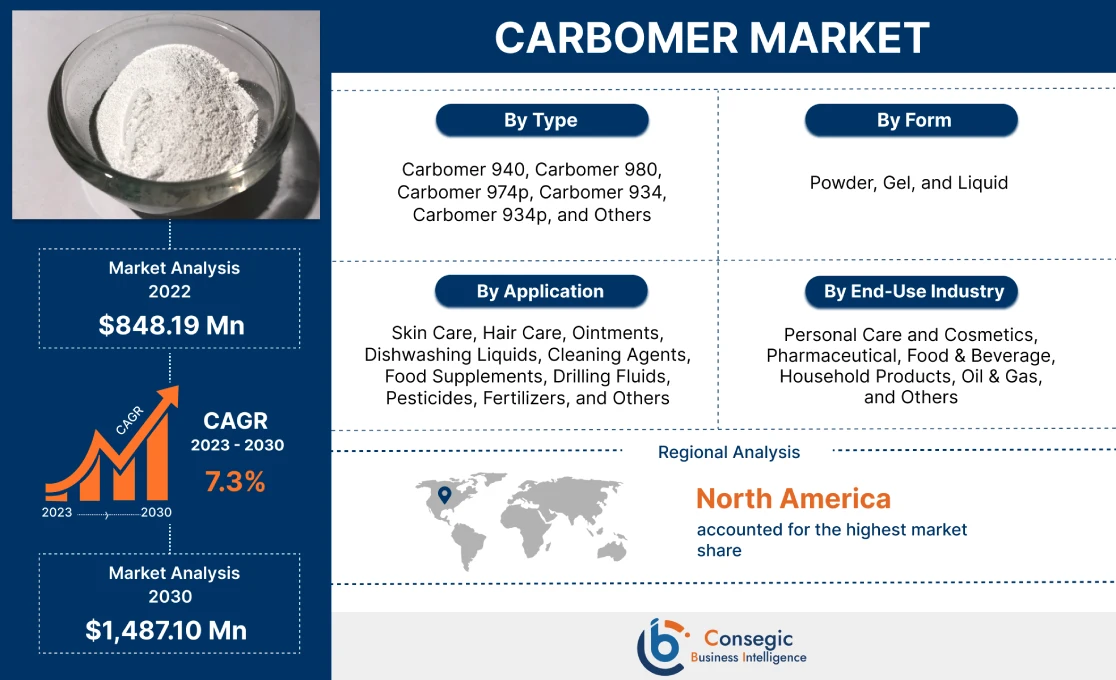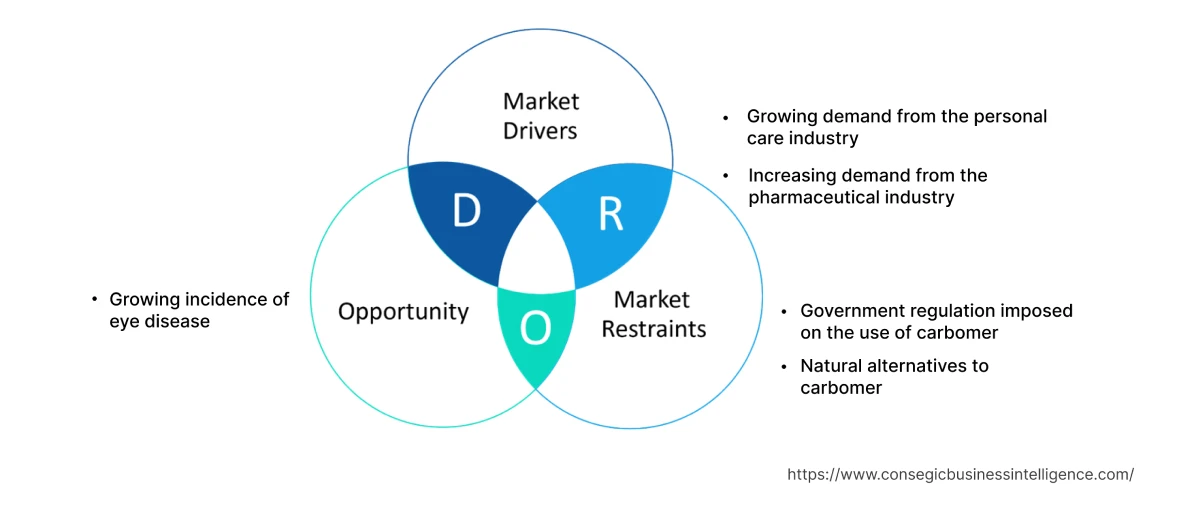Carbomer Market Size :
Consegic Business Intelligence analyzes that the Carbomer market size is growing with a healthy CAGR of 7.3% during the forecast period (2023-2030), and the market is projected to be valued at USD 1,487.10 million by 2030 from USD 848.19 million in 2022.
Carbomer Market Scope & Overview:
Carbomer are a type of polymer commonly known as polyacrylic acid having the chemical formula C3H4O2. They are synthetic, cross-linked polymers of acrylic acid with a high molecular weight.It commercialized in different forms namely, powder, liquid, and gel. The different types provide different functions in various end-use industries such as personal care and cosmetics, pharmaceuticals, food & beverage, household products, and others.
In the pharmaceutical sector, various grades of these compounds are available. Each grade has its significance and applicability in pharmaceutical dosage forms. In pharmaceutical processes, they are used as suspending agents, gel bases, emulsifiers, and binding agents. Furthermore, these compounds absorb and retain water, and enhance the appearance of pharmaceutical formulations.
Carbomer Market Insights :
Carbomer Market Dynamics - (DRO) :
Key Drivers :
Growing demand from the personal care sector
Carbomer is used as a thickening and stabilizing agent in personal care products such as serums, gels, creams, and lotions. They help to improve the texture, and viscosity of skin care products making them more effective in moisturizing and protecting the skin. As per the analysis, increasing awareness regarding personal grooming and hygiene is boosting the demand for personal care products, which is boosting the carbomer market demand.
For instance, according to the statistics published by Cosmetics Business, in 2020, the U.S. was home to the largest beauty and personal care market in the world, valued at USD 93 billion. While China held the second-largest personal care market valued at USD 71 billion. Hence, the rising demand for beauty and personal care products is boosting the revenue of the global carbomer market.
Increasing demand from the pharmaceutical sector
In the pharmaceutical sector, these compounds acts as a bioavailability enhancer, and control the release of drugs so the body can easily absorb them. In pharmaceutical processes, they are used as suspending agents, gel bases, emulsifiers, and binding agents. They are also used as artificial tears. Further, based on the analysis, these components are used as a permanent suspension of insoluble ingredients present in oral and topical medications.
For instance, according to the Organization for Economic Co-operation and Development, the pharmaceutical sector worldwide is forecasted to grow by 317%, from 2017 to 2060. However, in India, the pharmaceutical sector is forecasted to increase by 754% between 2017 to 2060.Hence, the increasing development of the pharmaceutical sector worldwide is boosting the adoption of these compounds in liquid and semi-solid pharmaceutical formulations which are amplifying the market trends.
Key Restraints :
Government regulation imposed on the use of carbomer
Carbomer is a type of synthetic polymer or microplastic that is used in many beauty and skincare products such as shampoos, shower gels, moisturizers, and eye creams, among others. However, microplastic in cosmetic products is considered one of the major contributors to primary microplastic pollution in aquatic environments.
These microplastic have been found to affect development, growth, behavior, and reproduction in many aquatic species as they accumulate in their bodies and invade their cells. As a result, based on the analysis, few governmental organizations are restricting the usage of synthetic polymers or microplastic to decrease their environmental impact.
For instance, in August 2022, the European Commission released a draft proposal to restrict intentionally added microplastics. The restriction would comprise synthetic polymer microparticles below 5 mm such as carbomers. Hence, such types of government regulation imposed on the use of these compounds are hampering the expansion of the market.
Natural alternatives to carbomer
Carbomers are synthetic ingredients that are used by cosmetics and pharmaceutical companies for the manufacturing of various pharmaceutical formulations and personal care products such as creams, lipsticks, nail paints, and others. However, the presence of natural alternatives and the rising consumer shift from chemical-based synthetic cosmetics to natural cosmetics is limiting the market.
For instance, Alban Muller International developed Amigel, a 100% alternative to these compounds and other synthetic ingredients used in the formulation of cosmetic products. Amigel is comprised of 100% naturally derived polysaccharides with excellent thickening and gelling properties. It is an incomparable stabilizing agent for the formulation of emulsions and suspensions and further offers moisturizing properties as well as a uniquely soft and supple texture to cosmetic products. Hence, the presence of such types of natural alternatives to these compounds is likely to hinder the growth.
Future Opportunities :
Growing incidence of eye disease
The growing prevalence of eye-related problems are among the factors creating lucrative carbomer market opportunities and trends in the upcoming years. The leading causes of blindness and low vision are due to primarily age-related eye diseases such as age-related macular degeneration, cataract, dry eye disease, and glaucoma. Further, eye gels are effective to treat the severe symptoms caused by such types of eye diseases. As per the analysis, this compound is the active ingredient used in the manufacturing of eye gels as they prevent the separation of oil and liquid parts of a gel formulation. Further, these materials suspend and distribute the insoluble solids which are unable to dissolve into the liquid. This property helps to stabilize the eye gel resulting in a longer shelf life.
For instance, according to the National Library of Medicine, the incidence of cataracts surges with age, ranging from 3.9% among 55–64 years to 92.6% among those who are 80 years and older. Hence, the higher occurrence of eye disease is expected to create lucrative opportunities and trends during the forecast period.
Carbomer Market Report Insights :
| Report Attributes | Report Details |
| Study Timeline | 2017-2030 |
| Market Size in 2030 | USD 1,487.10 Million |
| CAGR (2023-2030) | 7.3% |
| By Type | Carbomer 940, Carbomer 980, Carbomer 974p, Carbomer 934, Carbomer 934p, and Others |
| By Form | Powder, Gel, and Liquid |
| By Application | Skin Care, Hair Care, Ointments, Dishwashing Liquids, Cleaning Agents, Food Supplements, Drilling Fluids, Pesticides, Fertilizers, and Others |
| By End-Use Industry | Personal Care and Cosmetics, Pharmaceutical, Food & Beverage, Household Products, Oil & Gas, and Others |
| By Geography | North America, Europe, Asia Pacific, Latin America, and Middle East & Africa |
| Key Players | The Lubrizol Corporation, Sumitomo Seika Chemicals Co., Ltd., Corel Pharma Chem., Azelis Canada Inc., Anhui Newman Fine Chemicals Co., Ltd., Hopax Chemicals Mfg. Co., Ltd., Maruti Chemicals, Shreeji Chem., Libraw Pharma, Otto Chemie Pvt. Ltd., and Ashahi Chemical Industries (P) Ltd. |
Carbomer Market Segmental Analysis :
By Type :
The type segment is categorized into carbomer 940, carbomer 980, carbomer 974p, carbomer 934, and carbomer 934p. In 2022, the carbomer 940 segment accounted for the highest share in the market owing to its widespread use in imparting cosmetic products with a luxurious texture and further controlling their consistency and flow.
Based on the analysis, Carbomer 940 is generally used in hand hygiene products such as hand washing gels and hand sanitizers to provide viscosity and enhance the texture of the product. Hand sanitizers containing this compound have a thick gel-like consistency, which helps to prevent the product from running off the hands quickly.
For instance, according to the Ministry of Consumer Affairs, Food & Public Distribution, in 2020, the production of hand sanitizer was worth USD 12,100.35 liter per annum and production increased to worth USD 4,71,913.65 liter in 2021. Hence, the increasing concern related to hygiene is driving the demand for sanitizers, in turn, boosting the development of the carbomer market trends.
However, carbomer 980 is expected to be the fastest-growing segment in the carbomer market during the forecast period owing to its exceptional properties such as an efficient thickening agent, exceptional short flow (non-drip) property, and suspending ability at low quantity. Thus, the utilization of this compound is creating lucrative trends in the upcoming years.
By Form :
The form segment is classified into powder, gel, and liquid. In 2022, the gel segment accounted for the highest carbomer market share of 48.68% in the market and is expected to grow at the fastest CAGR over the forecast period. It is widely employed as a gel in a variety of cosmetics and personal care products such as hair styling gels, hydroalcoholic gels, moisturizing gels, shower gels, and others. Furthermore, as per the analysis, carbomer gel is widely used as an active ingredient in eye lubrication medication to relieve eye dryness and soreness which is a key driver for the expansion of the market trend.
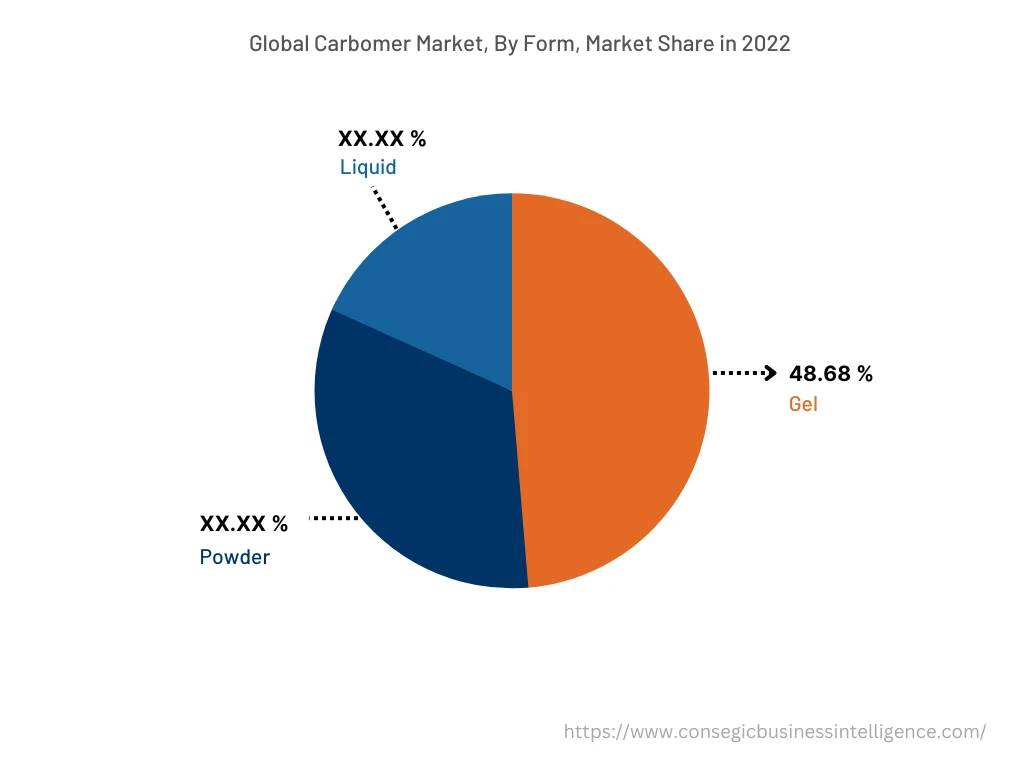
By Application :
The application segment is categorized into skin care, hair care, ointments, dishwashing liquids, cleaning agents, food supplements, drilling fluids, pesticides, fertilizers, and others. In 2022, the skin care application segment accounted for the highest market share in the market. In skin care products, the compound is used to regulate the consistency and flow of products, as well as provide lotions, creams, and gels with smooth and silky quality and texture which are the key factor driving the market.
However, the food supplements is expected to be the fastest-growing segment in the carbomer market during the forecast period. Food supplements help to improve and maintain overall health and add essential nutrients to the diet. They are widely used as stabilizer in solid and liquid food supplements to attain an extended shelf life.
Several governmental organizations are encouraging the use of these compounds in food supplements. For instance, The European Commission has permitted the usage of this compound as an additive in food supplements for the controlled extended release of nutrients, which will allow smaller tablet sizes that are easier for consumers to swallow. Thus, the increasing consumption of food supplements and various government initiatives are boosting the development of the market.
By End-User Industry :
The end-user segment is classified as personal care and cosmetics, pharmaceuticals, food & beverage, household products, oil & gas, and others. In 2022, the food and beverage segment accounted for the highest revenue of the carbomer industry. The compounds are used to improve the bioavailability of certain nutrients in food supplements. Further, these compounds improve the consistency and texture of food supplements such as salad dressings, sauces, or gravies which is the key factor driving the segment growth and trends.
However, the personal care and cosmetic sector is expected to be the fastest-growing segment in the carbomer market during the forecast period. This is driven by the increasing use of these compounds as a thickening agent making the product more viscous and maintaining its texture, flow, and consistency.
This compound is used in the manufacturing of numerous cosmetic products such as lotions, shampoos, lipsticks, nail polishes, and others. They are mainly used in cosmetic formulations to improve the texture and consistency of the product as well as enhance product performance. Additionally, the compounds are declared safe and non-toxic for their usage in cosmetic products.
For instance, the Cosmetic Ingredient Review (CIR) Expert Panel specified that carbomers are safe to use for cosmetics according to their present use and concentration which is a crucial factor anticipated to drive the carbomer market growth and trends
By Region :
The regional segment includes North America, Europe, Asia Pacific, Middle East and Africa, and Latin America.
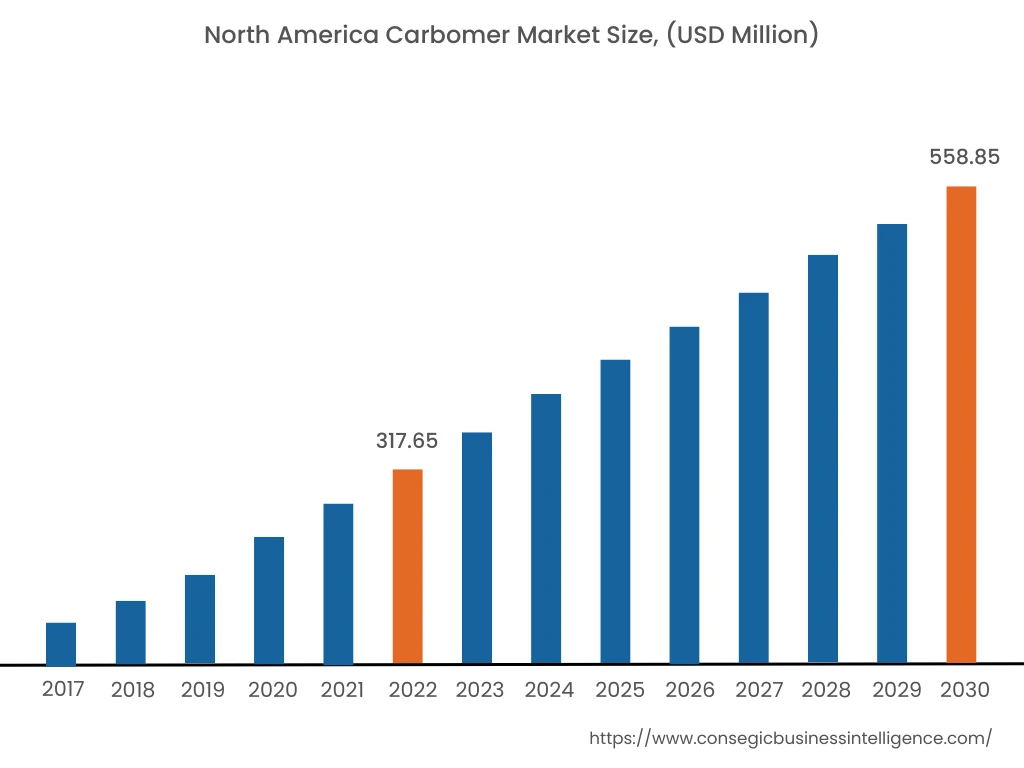
In 2022, North America accounted for the highest market share at 37.45% and was valued at USD 317.65 million, and is expected to reach USD 558.85 million in 2030. In North America, the U.S. accounted for the highest market share of 63.35% during the base year of 2022. The growth is attributed to the presence of large-scale manufacturers of cosmetics in the region which requires these components for the production of various cosmetic products. Further, the growing pharmaceutical and food sector particularly in the U.S. is boosting the revenue growth of the market in the region.
However, Asia Pacific is expected to grow at fastest CAGR of 7.8% over the forecast period in the market. Based on the carbomer market analysis, the growth is attributed to the increasing consumer spending on healthcare, favorable government regulations for the use of this compound in various end-use industries, and increasing export shipments, particularly in India and China.
For instance, according to Volza's China Export data, India is the largest exporter of this compounds with 2,558 shipments followed by China with 1,769 shipments which is a key driver anticipated to increase the market growth in the region.
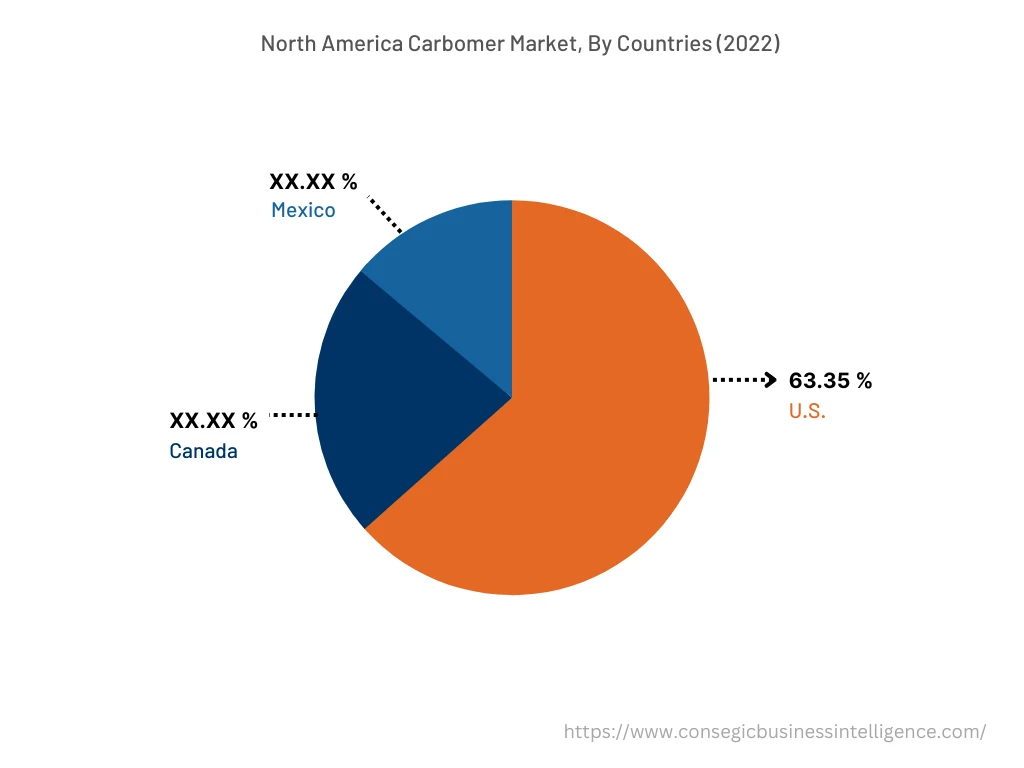
Top Key Players & Market Share Insights:
The carbomer market is highly competitive, with several large players and numerous small and medium-sized enterprises. These companies have strong research and development capabilities and a strong presence in the market through their extensive product portfolios and distribution networks. The market is characterized by intense competition, with companies focusing on expanding their product offerings and increasing their market revenue through mergers, acquisitions, and partnerships. The key players in the market include -
- Sumitomo Seika Chemicals Co., Ltd.
- Corel Pharma Chem.
- Azelis Canada Inc.
- Anhui Newman Fine Chemicals Co., Ltd.
- Hopax Chemicals Mfg. Co., Ltd.
- Maruti Chemicals
- Shreeji Chem.
- Libraw Pharma
- Otto Chemie Pvt. Ltd.
- Ashahi Chemical Industries (P) Ltd.
Recent Industry Developments :
- In August 2021, SPI Pharma announced an exclusive agreement with Azelis Americas, where Azelis Americas company will distribute the SPI Pharma product lines in the U.S.
- In April 2020, Lubrizol Advanced Materials, Inc., announced an increase in the production of its Carbopol polymers which is present in most hand sanitizing gels and cleansing applications in the global fight against COVID-19.
Key Questions Answered in the Report
What was the market size of the carbomer industry in 2022? +
In 2022, the market size of carbomer was USD 848.19 million
What will be the potential market valuation for the carbomer industry by 2030? +
In 2030, the market size of carbomer will be expected to reach USD 1,487.10 million.
What are the key factors driving the growth of the carbomer market? +
Increasing demand for carbomer from the personal care and pharmaceutical industries are the key factors driving the growth of the carbomer market.
What is the dominating segment in the carbomer market by type? +
In 2022, the carbomer 940 segment accounted for the highest market share in the overall carbomer market.
Based on current market trends and future predictions, which geographical region will have the fastest impact on the carbomer market's growth in the coming years? +
Asia Pacific is expected to be the fastest-growing region in the market during the forecast period.
